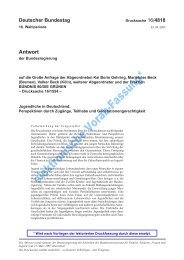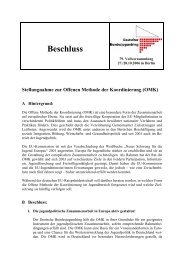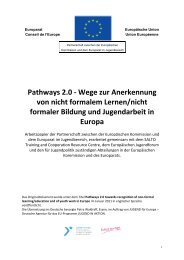National Quality Standards Framework (NQSF) - Homeless Agency
National Quality Standards Framework (NQSF) - Homeless Agency
National Quality Standards Framework (NQSF) - Homeless Agency
Create successful ePaper yourself
Turn your PDF publications into a flip-book with our unique Google optimized e-Paper software.
Timeline for the <strong>NQSF</strong><br />
Ensuring quality service provision takes time to achieve. It is difficult to definitively state the time commitment that will<br />
be involved in the implementation of the <strong>NQSF</strong>. This depends on a number of factors, such as:<br />
■■<br />
■■<br />
■■<br />
the stage of organisational development of the organisation;<br />
the existence of quality assurance processes within the organisation;<br />
the level of organisational support within the organisation and the culture of monitoring, review and evaluation<br />
in place.<br />
The <strong>NQSF</strong> will be implemented on a 3-yearly cycle within each youth organisation (see Figure 2). In Year 1 of<br />
implementation, the full self-assessment and external assessment processes will take place. In Years 2 and 3,<br />
organisations will be required to continue to self-assess, to progress the actions outlined in their Continuous<br />
Improvement Plan (CIP) and to complete their Progress Report in consultation with the VEC Officer/<strong>NQSF</strong> <strong>Standards</strong><br />
Officer. Following Year 3, the cycle of implementation of the <strong>NQSF</strong> will come full circle and the organisation will be<br />
required to recommence the <strong>NQSF</strong> process, as in Year 1.<br />
As a guideline, in Year 1 of implementation, the <strong>NQSF</strong> will involve a commitment of approximately one day per month.<br />
Central to this will be the work involved in the <strong>NQSF</strong> Implementation Team. It is recommended that each organisation<br />
establish a <strong>NQSF</strong> Implementation Team, the function of which is to lead the implementation of the <strong>NQSF</strong> and to ensure<br />
that progress is made in the ongoing process of continuous development. It should also be noted that outside of the<br />
structured meetings of the Implementation Team, work will also need to be progressed at an individual level. This parallel<br />
process will ensure that progress is being made in addressing the identified areas for development.<br />
7<br />
Ideally, the <strong>NQSF</strong> should be used to support what is currently happening in organisations and their services. It can be<br />
used as a framework and reference point for team meetings, service reviews, operational and strategic planning events<br />
and, where appropriate, to inform reporting requirements. If there are existing structures within the organisation that<br />
are deemed effective, these could be tasked with implementing the <strong>NQSF</strong>. Therefore, rather than the creation of new<br />
structures and tasks, what may be required is a restructuring and refocusing of the work that is already being carried out.
















